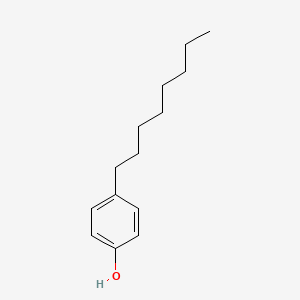D0744 | 4-octylphenol
| Toxicity | Dose | Time | Species | Model | Method | Action | Positive criterion | Reference |
|---|---|---|---|---|---|---|---|---|
| MEMBRANE POTENTIAL | 8.77±2.96 | human | qHTS-HepG2 | MMP assay | decrease | IC50 | 163 | |
| MEMBRANE POTENTIAL | 14.13 | human | HepG2 | MMP assay | decrease | IC50 | 163 | |
| MEMBRANE POTENTIAL | 53.18±4.32 | rat | hepatocytes | MMP assay | decrease | IC50 | 163 | |
| Pictogram | Signal | Statements | Precautionary Statement Codes |
|---|---|---|---|
 |
Danger |
Aggregated GHS information provided by 551 companies from 4 notifications to the ECHA C&L Inventory. Each notification may be associated with multiple companies. Reported as not meeting GHS hazard criteria by 62 of 551 companies. For more detailed information, please visit ECHA C&L website Of the 3 notification(s) provided by 489 of 551 companies with hazard statement code(s): H314 (91.21%): Causes severe skin burns and eye damage [Danger Skin corrosion/irritation] H318 (90.18%): Causes serious eye damage [Danger Serious eye damage/eye irritation] Information may vary between notifications depending on impurities, additives, and other factors. The percentage value in parenthesis indicates the notified classification ratio from companies that provide hazard codes. Only hazard codes with percentage values above 10% are shown. |
P260, P264, P280, P301+P330+P331, P303+P361+P353, P304+P340, P305+P351+P338, P310, P321, P363, P405, and P501; (The corresponding statement to each P-code can be found at the GHS Classification page.) |
 |
Warning |
H302: Harmful if swallowed [Warning Acute toxicity, oral] |
P264, P270, P301+P312, P330, and P501; (The corresponding statement to each P-code can be found at the GHS Classification page.) |
 |
Warning |
H361: Suspected of damaging fertility or the unborn child [Warning Reproductive toxicity] H371: May cause damage to organs [Warning Specific target organ toxicity, single exposure] |
P201, P202, P260, P264, P270, P281, P308+P313, P309+P311, P405, and P501; (The corresponding statement to each P-code can be found at the GHS Classification page.) |
| Organism | Test type | Route | Dose (normalized dose) | Effect | Source |
|---|---|---|---|---|---|
| mouse | LD50 | intraperitoneal | 25mg/kg (25mg/kg) | National Technical Information Service. Vol. AD277-689, | |
| 1-(p-Hydroxyphenyl)octane | 1806-26-4 | 4-OCTYLPHENOL |
| 4-Octyl-phenol | 4-Octylphenol, 99% | 4-Octylphenol, analytical standard |
| 4-n-Octylphenol | 4-n-Octylphenol 10 microg/mL in Isooctane | 4-octyl phenol |
| 71902-25-5 | 7DF2B8LH3P | A812553 |
| AKOS002685659 | AS-40771 | AX8018965 |
| BDBM74109 | BIDD:ER0059 | C-42368 |
| C14132 | CAS-1806-26-4 | CHEBI:34432 |
| CHEMBL195437 | CTK0I1232 | DSSTox_CID_2312 |
| DSSTox_GSID_22312 | DSSTox_RID_76545 | DTXSID9022312 |
| EINECS 217-302-5 | EINECS 276-174-9 | FT-0619333 |
| HSDB 5857 | J-011534 | KS-000018CH |
| LS-105015 | MCULE-2695490410 | MFCD00036134 |
| MLS001055340 | NCGC00090986-01 | NCGC00090986-02 |
| NCGC00090986-03 | NCGC00090986-04 | NTDQQZYCCIDJRK-UHFFFAOYSA-N |
| OP (TENTATIVE) | Phenol, 4-octyl- | Phenol, octenylated |
| Phenol, p-octyl- | Phenol, reaction product with octene | Q27116060; |
| QC-607 | RT-003621 | SBB059157 |
| SCHEMBL18809 | SMR000677939 | ST033354 |
| Tox21_400015 | UNII-7DF2B8LH3P | ZINC2039235 |
| cid_15730 | p-Octylphenol | p-octyl phenol |
| para-Octylphenol |

